Kyoto, the ancient capital of Japan, is home to countless historic shrines and temples.
Kiyomizu-dera Temple, Fushimi Inari-taisha Shrine, and Kinkaku-ji Temple are the most popular and classic spots for sightseeing in Kyoto, but there are many other attractive temples and shrines as well.
In this article, I, a Kyoto resident, would like to share with you three temples that I would like travelers to see.
1. Sanjūsangen-dō
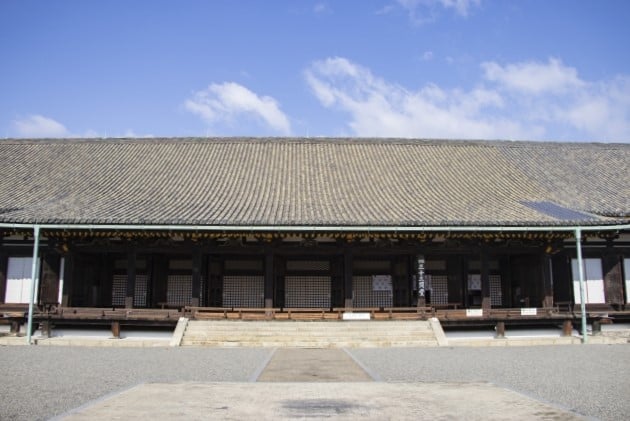
Sanjūsangen-dō, located in Higashiyama-ku, Kyoto, was completed in 1165, but was destroyed by fire in 1249, and only the main hall was rebuilt in 1266.
The main hall, a standing image of Senju Kannon, a seated image of Senju Kannon, statues of the Wind God and Thunder God, and 28 elephants are designated national treasures.
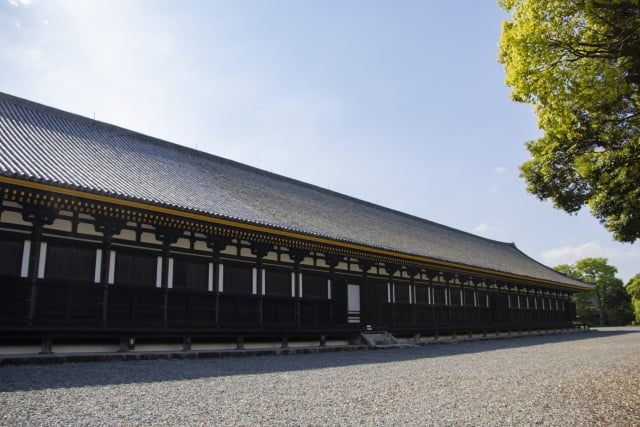
Sanjūsangen-dō is said to get its name from the 33 pillars between the pillars in the long hall, which measures approximately 120 meters from north to south.
The beauty and solemnity of the long hall is breathtaking.
In addition, there is a garden with a pond and a circular garden, which was completed in 2021, and visitors can enjoy seasonal flowers in the garden centered around a pond. Visitors can enjoy seasonal flowers in the garden centered around a pond, as well as see up close valuable historical buildings designated as Important Cultural Properties, such as Nandaimon and Taiko-Fence.
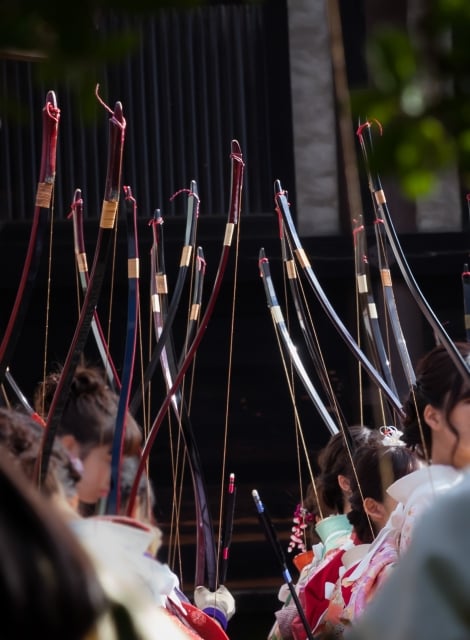
The Sanjūsangen-dō Oomatotaikai, held on a Sunday in mid-January, is an annual archery tournament held in the 120-meter hall of Sanjusangendo. 2000 people from all over Japan participate in this event every year.
The competition, in which newly-arrived adults who have turned 20 years old participate in kimonos, has a glamorous atmosphere unique to the Japanese New Year. The competition is free and open to the public, so visitors to Kyoto in January should definitely visit.
▼ Rengeoin Sanjūsangen-dō
Address: Sanjūsangen-dō Mawarimachi 657, Higashiyama-ku, Kyoto-shi, Kyoto
Phone:075-561-0467
Hours: (April 1-November 15) 8:30 am-5 pm (November 16-March 31) 9 am-4 pm
Admission: Adults 600 yen / Junior and senior high school students 400 yen / Elementary school students 300 yen
Access: 7 min. walk from Exit 2 of Shichijo Station of Keihan Railway
Official website:https://www.sanjusangendo.jp/
2. Ryōan-ji
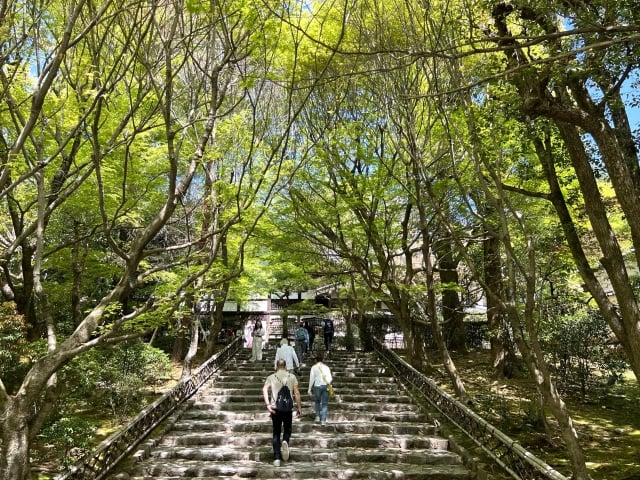
Located in Ukyo-ku, Kyoto City, about a 20-minute walk from Kinkakuji Temple, Ryōan-ji is a representative Zen temple in Kyoto and is registered as a World Heritage site.
Founded in 1450, the temple was destroyed by fire during the Onin War in 1467, but was rebuilt at this location.
The temple has been attracting a lot of attention from around the world ever since Zen was adopted widely.
A visit to Ryōan-ji is a good opportunity to learn more about Zen.
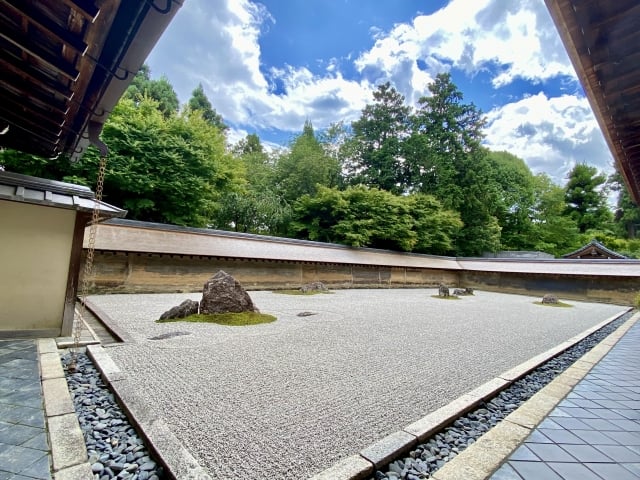
Ryōan-ji is famous for its Ishi-niwa (stone garden), a typical Japanese garden style called Karesansui, in which stones, sand, plants, and topography are used to express the flow of water in a place where there is no water.
The 15 stones are arranged in a row of 5, 2, 3, 2, 3, on a bed of white sand, and are arranged so that no matter where you view them from, one of the stones will be hidden from view.
The number 15, which represents perfection in the oriental world, is reduced by one to represent an imperfect garden.
When you visit the temple, try and count the number of stones from different places.
The garden, in which stones are used as islands and lines are drawn in the white sand to represent the flow of water, has been designated a special place of scenic beauty by the government and is said to be the ultimate space of Zen beauty.
It is said to be a space of Zen beauty at its finest.
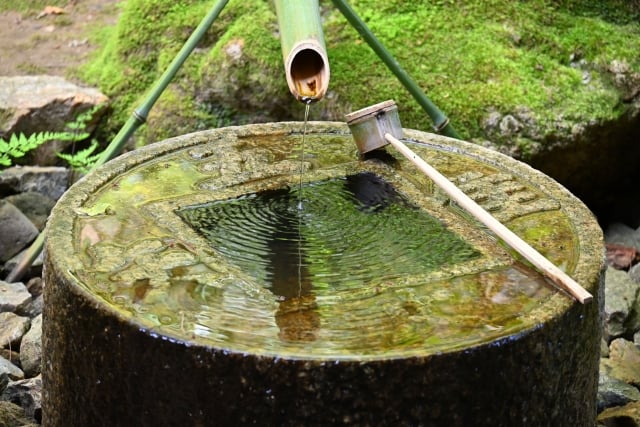
Another must-see is the chisoku no tsukubai (stone wash basin) located behind the hojo.
The basin was originally used for cleansing the hands and mouths of the participants for the tea ceremony. The square hole in the center of the chisoku no tsukubai is made to look like the Chinese character for mouth (口) and reads, clockwise from the top, "I know that I am just."
The meaning of "I know that I am just" expresses the spirit of the tea ceremony: We should not be dissatisfied with imperfection, but be content with what we have and be thankful for what we have.
You will be able to feel the traditional Japanese culture and spirit.
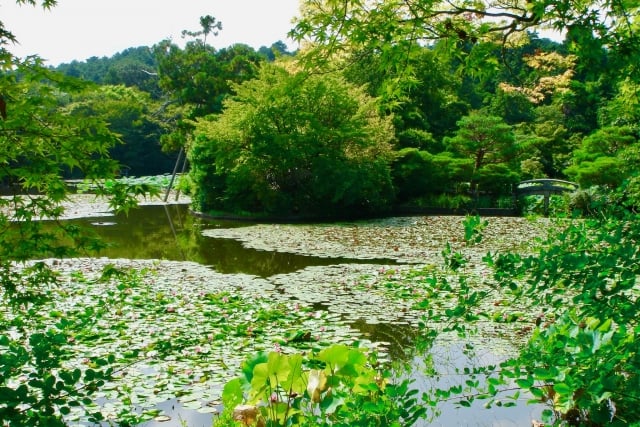
In addition, there is a vast Kyoyoike pond within the temple grounds, where you can enjoy beautiful seasonal flowers and plants.
In particular, the blooming water lilies, which are at their best in May and June, are so beautiful that you will want to take pictures of them. Please come and experience the beauty of Japan's four seasons with your own eyes.
▼ Ryōan-ji
Address: 13 Goryoshita-cho, Ryōan-ji, Ukyo-ku, Kyoto City, Kyoto Prefecture
Phone:075-463-1036
Hours: (March 1-November 30) 8 am-5 pm (December 1-February 31) 8:30 am-4:30 pm
Admission: 600 yen for adults, 500 yen for high school students, 300 yen for elementary and junior high school students
Access: 7 min. walk from Ryoanji Station on the Keifuku Electric Railway Line
Official website:http://www.ryoanji.jp/top.html
3. Byōdō-in
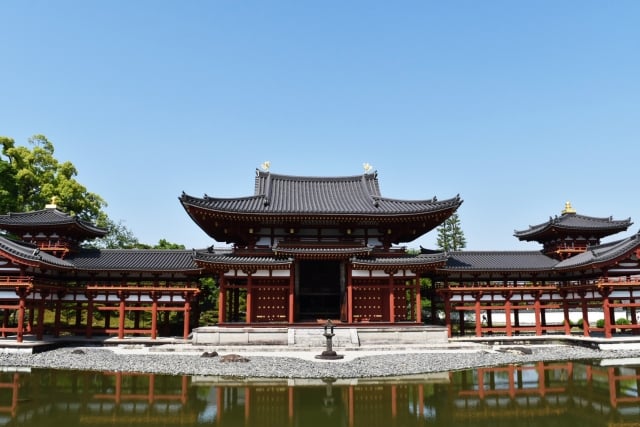
There is a temple called Byōdō-in in Uji City, Kyoto Prefecture, about a 10-minute walk from Uji Station, about 20 minutes by train from Kyoto Station.
Uji City is also the setting of the famous Japanese literary work The Tale of Genji, a long love story written during the Heian period (794 - 1185).
It is registered as a World Heritage site, and the Amida Hall (Phoenix Hall), where the seated statue of Amida Nyorai is enshrined, is so important that it is engraved on the Japanese ten-yen coin.
Built on an island in the middle of a pond, the elegant figure is beautifully reflected on the surface of the water, making it a good spot for photographs.
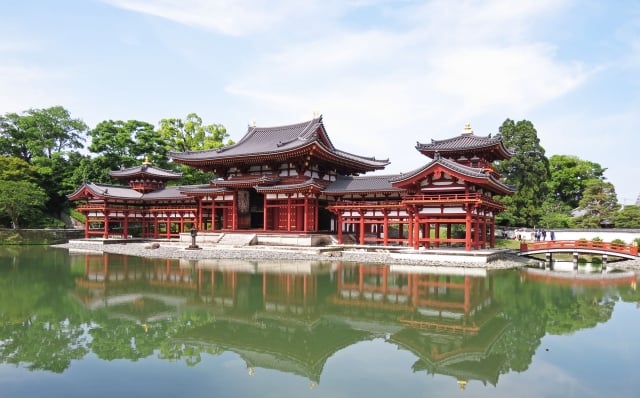
Inside the Phoenix Hall, a seated statue of Amida Nyorai, a national treasure, is enshrined in the center, and 52 statues of Bodhisattvas making offerings in the clouds line the surrounding walls.
Riding on the flying clouds, playing musical instruments, dancing, and holding their palms together, the Bodhisattvas are known for their lively and happy moods, making this a good place for those who want to experience the world of Buddhism.

The temple grounds, centering on the Phoenix Hall that seems to float on a pond, are filled with beautiful seasonal flowers such as wisteria, cherry blossoms, water lilies, and autumn leaves. A leisurely stroll while listening to the chirping of birds is recommended.
The Museum Hoshokan houses a Buddhist temple bell and 26 statues of Bodhisattvas making offerings to the gods in the clouds, as well as excavated artifacts and computer-generated images using the latest digital technology. The museum shop is also located next to the museum.
Visitors can also purchase stationery, sundries, and other original goods at the museum store located next to the museum.
After visiting the temple, a good sightseeing route is to go to Chabo Fujihana, a Japanese tea store where you can taste locally produced Uji tea, and enjoy a wide variety of Japanese teas and sweets, including matcha and sencha teas.
▼ Byōdō-in
Address: 116, Uji Renge, Uji City, Kyoto, Japan
Phone:0774-21-2861
Closed: Open year-round / *The Tea Room is closed on Mondays, Tuesdays, and Wednesdays. Open on national holidays.
Hours: (Garden) 8:30 am- 5:30 pm / (Inside the Phoenix Hall) 9:30 am- 4:10 pm * Capacity of 50 people per visit, first-come-first-served basis / (Byodoin Museum Hoshokan) 9 am - 5 pm / (Tea House Fujika) 10 am - 4:30 pm
Admission: 700 yen for adults, 400 yen for junior high and high school students, 300 yen for elementary school students / * 300 yen plus if you wish to see the inside of the Phoenix Hall.
Access: 10 min. walk from JR/Keihan Uji station
Official website:https://www.byodoin.or.jp/
Let's go out to Kyoto's unique temples!
As you can see, Kyoto's temples and shrines have their own histories and personalities.
When sightseeing in Kyoto, be sure to visit several temples, shrines, and Buddhist temples to enjoy their diverse charms.
